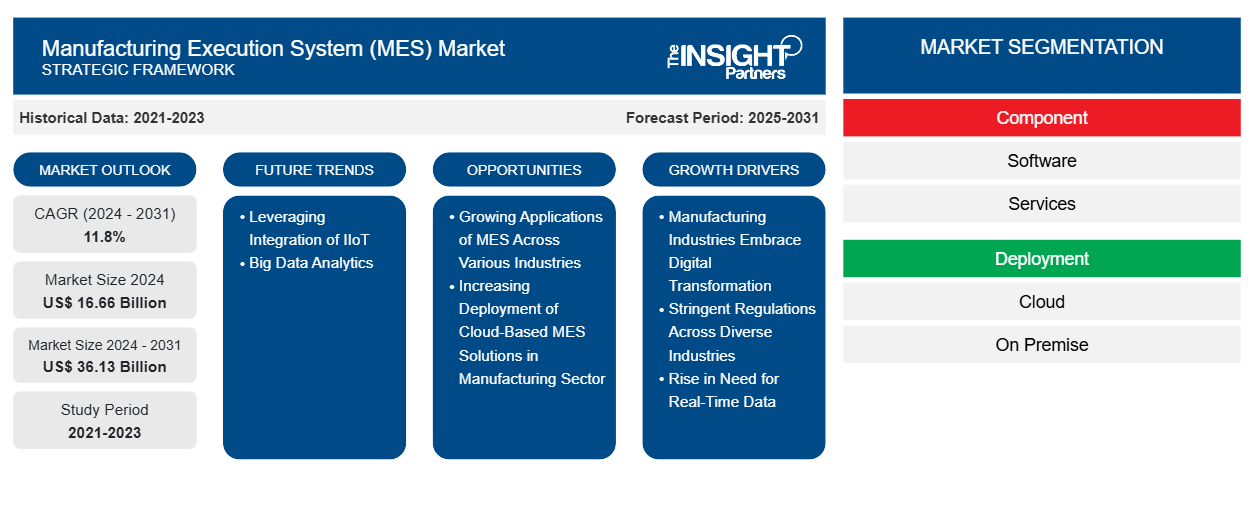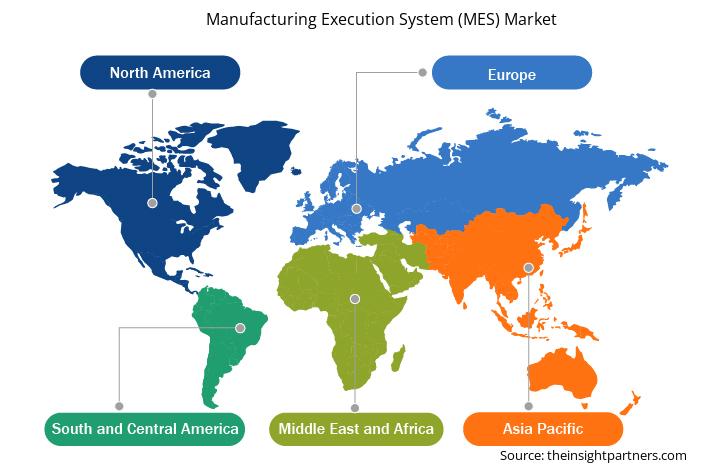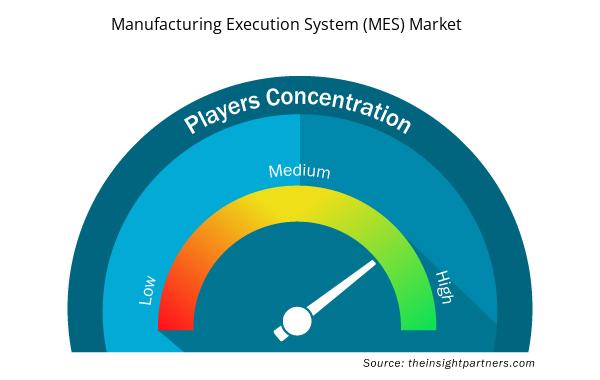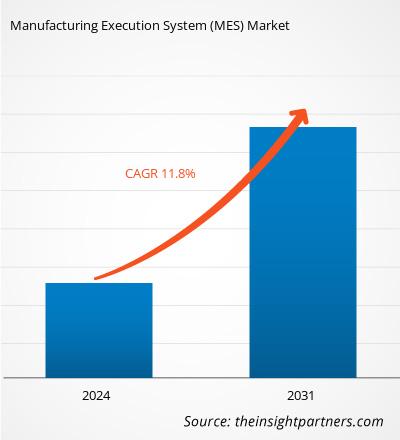قُدِّر حجم سوق أنظمة تنفيذ التصنيع (MES) بـ 16.66 مليار دولار أمريكي في عام 2024، ومن المتوقع أن يصل إلى 36.13 مليار دولار أمريكي بحلول عام 2031؛ ومن المتوقع أن يُسجِّل معدل نمو سنوي مركب قدره 11.8% خلال الفترة 2024-2031. ومن المرجح أن يظل الاستفادة من تكامل إنترنت الأشياء الصناعي (IIoT) وتحليلات البيانات الضخمة اتجاهًا رئيسيًا في السوق.
تحليل سوق نظام تنفيذ التصنيع (MES)
تُسهم عواملٌ مثل انخراط الصناعات التحويلية في التحول الرقمي، واللوائح الصارمة في مختلف الصناعات، والحاجة المتزايدة للبيانات الفورية، في نمو سوق أنظمة تنفيذ التصنيع (MES) . ومن المتوقع أن يُتيح الاستخدام المتزايد لأنظمة تنفيذ التصنيع في مختلف الصناعات، وظهور حلولها السحابية في قطاع التصنيع، فرصًا لتوسيع سوق أنظمة تنفيذ التصنيع (MES). علاوةً على ذلك، من المتوقع أن يُسهم دمج إنترنت الأشياء الصناعي (IIoT) وتحليلات البيانات الضخمة في إرساء اتجاهات جديدة لسوق أنظمة تنفيذ التصنيع (MES).
نظرة عامة على سوق نظام تنفيذ التصنيع (MES)
نظام تنفيذ التصنيع (MES) هو نظام برمجي شامل وديناميكي يراقب عملية التصنيع بأكملها، ويتتبعها، ويوثقها، ويديرها، بدءًا من المواد الخام وصولًا إلى المنتجات النهائية. يعمل نظام تنفيذ التصنيع كحلقة وصل بين نظام تخطيط موارد المؤسسة (ERP) وأنظمة التحكم في العمليات، موفرًا لصانعي القرار البيانات اللازمة لتحسين كفاءة المصنع. يتيح نظام تنفيذ التصنيع للمؤسسات تتبع عملية التصنيع بأكملها والتحكم فيها، بدءًا من استلام المواد الخام وحتى تسليم المنتج النهائي . يشمل ذلك معالجة أوامر العمل، والتحقق من جودة المنتج، ومراقبة أداء الآلات، وجمع البيانات طوال عملية الإنتاج.
يُستخدم برنامج MES لإدارة ومراقبة وتنسيق العمليات المادية والكوادر البشرية المشاركة في تحويل المواد الخام إلى سلع وسيطة أو مُصنّعة في الوقت الفعلي. كما يوفر بيانات عملية تُساعد صانعي القرار في قطاع التصنيع على فهم كيفية تحسين ظروف التشغيل في المصنع لزيادة الإنتاج. يعمل برنامج MES كحلقة وصل بين إدارة دورة حياة المنتج (PLM) وأنظمة تخطيط موارد المؤسسات (ERP) والآلات (OT). تُحسّن هذه الطبقة البرمجية كفاءة وجودة عملية الإنتاج، مما يُؤدي إلى زيادة الإنتاجية والربحية.
قم بتخصيص هذا التقرير ليناسب متطلباتك
ستحصل على تخصيص لأي تقرير - مجانًا - بما في ذلك أجزاء من هذا التقرير، أو تحليل على مستوى الدولة، وحزمة بيانات Excel، بالإضافة إلى الاستفادة من العروض والخصومات الرائعة للشركات الناشئة والجامعات
سوق نظام تنفيذ التصنيع (MES):

- احصل على أهم اتجاهات السوق الرئيسية لهذا التقرير.ستتضمن هذه العينة المجانية تحليل البيانات، بدءًا من اتجاهات السوق وحتى التقديرات والتوقعات.
محركات وفرص سوق نظام تنفيذ التصنيع (MES)
لوائح صارمة عبر مختلف الصناعات
يضمن نظام MES الامتثال للقطاع من خلال إمكانية التتبع الكامل وتسجيل البيانات. فهو يسجل معلومات شاملة حول المكونات الخام والمكونات والعمليات والعاملين المشاركين في التصنيع. تُمكّن هذه البيانات المصنّعين من تلبية المعايير التنظيمية والحفاظ على معايير عالية. على سبيل المثال، يمكن لنظام MES توثيق كل مرحلة من مراحل عملية التصنيع تلقائيًا، مما ينتج عنه مسار تدقيق مطلوب لعمليات التفتيش التنظيمية. كما أنه يحلل معايير مراقبة الجودة في الوقت الفعلي لضمان استيفاء المنتجات لمعايير الصناعة. في حالة حدوث أي انحرافات، يمكن لنظام MES إرسال تنبيهات واتخاذ إجراءات تصحيحية لضمان الامتثال. يُعد نظام MES العمود الفقري للعمليات اليومية في قطاع الأدوية، حيث يوفر إدارة دقيقة وفي الوقت الفعلي لجميع جوانب عملية التصنيع. في صناعة الأدوية، يُسهّل نظام MES سجلات الدفعات الإلكترونية (EBR) وفقًا لمعايير ممارسات التصنيع الجيدة (GMP) الصارمة. من خلال نشر نظام EBR، يضمن نظام MES توثيق كل مرحلة من مراحل الإنتاج بدقة، مما يقلل من خطر الأخطاء البشرية ويُبسّط إدارة العمليات اليومية. علاوة على ذلك، تُلبي أنظمة تنفيذ التصنيع (MES) في صناعة الأغذية والمشروبات جميع المعايير القانونية والصحية، بما في ذلك نظام تحليل المخاطر ونقاط التحكم الحرجة (HACCP). ويُفضّل تطبيق أنظمة تنفيذ التصنيع (MES) في صناعة الأغذية والمشروبات على مراحل، بدءًا من خطوط أو مناطق التصنيع المختارة للحد من أي انقطاعات في عملية التصنيع. وبالتالي، تُسهم المعايير التنظيمية الصارمة في مختلف الصناعات في نمو سوق أنظمة تنفيذ التصنيع (MES).
التطبيقات المتنامية لأنظمة التصنيع التنفيذي (MES) عبر مختلف الصناعات
يمكن تطبيق حلول نظام تنفيذ التصنيع (MES) وتعديلها لتلبية الاحتياجات المحددة لمختلف الصناعات، مثل صناعة السيارات والإلكترونيات والأدوية. في الوقت نفسه، تظل الوظيفة الأساسية لنظام تنفيذ التصنيع (MES) كما هي في جميع الصناعات. يساعد حل نظام تنفيذ التصنيع (MES) على مواكبة صناعة السيارات المتزايدة التعقيد والتغير السريع، ومواءمة عمليات التصنيع مع احتياجات السوق بشكل أفضل. يستخدم نظام تنفيذ التصنيع (MES) ثلاث وظائف رئيسية لتحقيق ذلك: إدارة العمليات، وإدارة المعلومات، وبوابة التكامل. يمكن أن يساعد استخدام نظام تنفيذ التصنيع (MES) موردي السيارات على مواكبة اتجاهات الصناعة المتغيرة. في صناعة السيارات، يلعب نظام تنفيذ التصنيع (MES) دورًا حيويًا في تنسيق خطوط التجميع المعقدة. يتتبع نظام تنفيذ التصنيع (MES) تقدم المركبات على خط التجميع، ويراقب توفر المكونات، ويزامن العمليات عبر محطات العمل المختلفة. يمكن لمصنعي البطاريات تحسين إدارة الجودة من خلال إمكانية التتبع الكامل من الخلط إلى التركيب. يمكن لمصنعي الإطارات الحفاظ على معايير الكفاءة والجودة مع إدارة خلطات الإطارات المعقدة. يمكن لنظام تنفيذ التصنيع (MES) تقديم تحسينات قابلة للقياس الكمي في العديد من المجالات. وفقًا لشركة روكويل أوتوميشن، يُمكن لأنظمة التصنيع التنفيذي (MES) خفض النفايات بنسبة تصل إلى 8%، ومدة التنفيذ بنسبة تصل إلى 45%، ومدة الدورة بنسبة تصل إلى 45%، وتكاليف العمالة بنسبة تصل إلى 50%، ومعدلات الرفض بنسبة تصل إلى 75%. ونتيجةً لذلك، تُستخدم هذه الأنظمة في مختلف الصناعات. وبالتالي، من المتوقع أن يُسهم الاستخدام المتزايد لأنظمة التصنيع التنفيذي في مختلف الصناعات في خلق فرص مربحة لنمو السوق.
تقرير تحليل تجزئة سوق نظام تنفيذ التصنيع (MES)
القطاعات الرئيسية التي ساهمت في اشتقاق تحليل سوق نظام تنفيذ التصنيع (MES) هي المكون، والنشر، وحجم المنظمة، ونوع الترخيص، وقناة المبيعات، والمستخدم النهائي.
- بناءً على مكونات السوق، يُقسّم السوق إلى برمجيات وخدمات. ويُقسّم قطاع الخدمات أيضًا إلى خدمات احترافية وخدمات مُدارة. وسيُهيمن قطاع البرمجيات على السوق في عام ٢٠٢٤.
- من حيث النشر، يُقسّم السوق إلى محلي وسحابي. ويُقسّم قطاع السحابة أيضًا إلى سحابات خاصة، وسحابات عامة، وسحابات هجينة. وقد استحوذت السحابة على أكبر حصة سوقية في عام ٢٠٢٤.
- ينقسم سوق أنظمة تنفيذ التصنيع (MES)، حسب حجم المؤسسة، إلى شركات كبيرة وصغيرة ومتوسطة. وسيهيمن قطاع الشركات الكبيرة على السوق في عام 2024.
- بناءً على نوع الترخيص، يُقسّم سوق أنظمة تنفيذ التصنيع (MES) إلى نظام مرخص ونظام قائم على الاشتراك. وقد هيمن قطاع أنظمة الاشتراك على السوق في عام 2024.
- بناءً على قنوات البيع، يُصنّف السوق إلى المبيعات المباشرة، وشركاء القنوات، ومقدمي الخدمات الخارجيين. وقد هيمن قطاع المبيعات المباشرة على السوق في عام ٢٠٢٤.
- بناءً على المستخدم النهائي، يُقسّم السوق إلى صناعات عملياتية وصناعات منفصلة. يُصنّف قطاع الصناعات التحويلية أيضًا إلى قطاعات الأغذية والمشروبات، والنفط والغاز، والكيماويات، واللب والورق، والكيماويات، والطاقة، والأدوية وعلوم الحياة، ومعالجة المياه والصرف الصحي، وغيرها. أما قطاع الصناعات المنفصلة، فيُقسّم إلى قطاعات السيارات، والإلكترونيات، وأشباه الموصلات، والفضاء والدفاع، والسلع الاستهلاكية المعبأة، والأجهزة الطبية، وغيرها. وسيُهيمن قطاع الصناعات المنفصلة على السوق في عام 2024.
تحليل حصة سوق أنظمة تنفيذ التصنيع (MES) حسب المنطقة الجغرافية
- يُقسّم سوق أنظمة تنفيذ التصنيع (MES) إلى خمس مناطق رئيسية: أمريكا الشمالية، وأوروبا، وآسيا والمحيط الهادئ، والشرق الأوسط وأفريقيا، وأمريكا الجنوبية والوسطى. هيمنت أمريكا الشمالية على سوق أنظمة تنفيذ التصنيع (MES) في عام 2024. وتُعدّ أوروبا ثاني أكبر مساهم في سوق أنظمة تنفيذ التصنيع (MES) العالمي، تليها آسيا والمحيط الهادئ.
- ينقسم سوق أنظمة تنفيذ التصنيع (MES) في أمريكا الشمالية إلى الولايات المتحدة وكندا والمكسيك. وتتمتع أمريكا الشمالية بحصة سوقية كبيرة، مدفوعةً بقاعدة التصنيع المتقدمة في المنطقة والاعتماد المبكر لتقنيات الصناعة 4.0. وتُعد الولايات المتحدة، على وجه الخصوص، موطنًا للعديد من موردي برامج أنظمة تنفيذ التصنيع، بما في ذلك رواد عالميون مثل روكويل أوتوميشن وهانيويل إنترناشونال. وينتشر اعتماد أنظمة تنفيذ التصنيع في أمريكا الشمالية في قطاعات مثل السيارات والفضاء والأدوية والإلكترونيات. ويعزز التركيز المتزايد على تحليلات البيانات الآنية وكفاءة الإنتاج والامتثال للوائح التنظيمية الطلب على حلول أنظمة تنفيذ التصنيع. علاوة على ذلك، يشهد السوق في أمريكا الشمالية نموًا كبيرًا مع تزايد إدراك المصنّعين والجهات الحكومية لفوائد مراقبة الإنتاج الآنية وتحسين العمليات. كما أن الحوافز الحكومية للتحول الرقمي واعتماد تقنيات الصناعة 4.0 تُسرّع الطلب على أنظمة تنفيذ التصنيع، مما يُعزز نمو السوق.
رؤى إقليمية حول سوق نظام تنفيذ التصنيع (MES)
قام محللو إنسايت بارتنرز بشرح شامل للاتجاهات الإقليمية والعوامل المؤثرة في سوق أنظمة تنفيذ التصنيع (MES) خلال فترة التوقعات. ويناقش هذا القسم أيضًا قطاعات سوق أنظمة تنفيذ التصنيع (MES) ونطاقها الجغرافي في أمريكا الشمالية، وأوروبا، وآسيا والمحيط الهادئ، والشرق الأوسط وأفريقيا، وأمريكا الجنوبية والوسطى.

- احصل على البيانات الإقليمية المحددة لسوق نظام تنفيذ التصنيع (MES)
نطاق تقرير سوق نظام تنفيذ التصنيع (MES)
| سمة التقرير | تفاصيل |
|---|---|
| حجم السوق في عام 2024 | 16.66 مليار دولار أمريكي |
| حجم السوق بحلول عام 2031 | 36.13 مليار دولار أمريكي |
| معدل النمو السنوي المركب العالمي (2024 - 2031) | 11.8% |
| البيانات التاريخية | 2021-2023 |
| فترة التنبؤ | 2025-2031 |
| القطاعات المغطاة | حسب المكون
|
| المناطق والدول المغطاة | أمريكا الشمالية
|
| قادة السوق وملفات تعريف الشركات الرئيسية |
|
كثافة اللاعبين في سوق نظام تنفيذ التصنيع (MES): فهم تأثيرها على ديناميكيات الأعمال
يشهد سوق أنظمة تنفيذ التصنيع (MES) نموًا سريعًا، مدفوعًا بتزايد طلب المستخدم النهائي نتيجةً لعوامل مثل تطور تفضيلات المستهلكين، والتقدم التكنولوجي، وزيادة الوعي بمزايا المنتج. ومع تزايد الطلب، تعمل الشركات على توسيع عروضها، والابتكار لتلبية احتياجات المستهلكين، والاستفادة من الاتجاهات الناشئة، مما يعزز نمو السوق.
تشير كثافة اللاعبين في السوق إلى توزيع الشركات العاملة في سوق أو قطاع معين. وتشير إلى عدد المنافسين (اللاعبين في السوق) الموجودين في سوق معين نسبةً إلى حجمه أو قيمته السوقية الإجمالية.
الشركات الرئيسية العاملة في سوق نظام تنفيذ التصنيع (MES) هي:
- SAP SE
- شركة أيه بي بي المحدودة
- داسو سيستمز إس إي
- شركة شنايدر إلكتريك SE
- شركة إيمرسون للكهرباء
- شركة جنرال إلكتريك
إخلاء المسؤولية : الشركات المذكورة أعلاه ليست مرتبة بأي ترتيب معين.

- احصل على نظرة عامة على أهم اللاعبين الرئيسيين في سوق نظام تنفيذ التصنيع (MES)
أخبار سوق نظام تنفيذ التصنيع (MES) والتطورات الأخيرة
يُقيّم سوق أنظمة تنفيذ التصنيع (MES) بجمع بيانات نوعية وكمية بعد البحث الأولي والثانوي، والتي تشمل منشورات الشركات المهمة، وبيانات الجمعيات، وقواعد البيانات. فيما يلي بعض التطورات في سوق أنظمة تنفيذ التصنيع (MES):
- أعلنت شركة إيمرسون لحلول الأتمتة عن توسيع شراكتها مع شركة إنفورمتريك سيستمز. قامت إيمرسون بدمج نظام إنفوباتش مع نظام سينكيد لتنفيذ التصنيع. أصبح بإمكان عملاء إيمرسون الآن تجميع البيانات من سينكيد ودلتا في وقواعد بيانات/مؤرخات خارجية باستخدام حزمة تقارير إنفوباتش.
(المصدر: إيمرسون أوتوميشن سوليوشنز، بيان صحفي، نوفمبر 2024)
- أعلنت شركة GE Digital، وهي جزء لا يتجزأ من محفظة أعمال الطاقة لشركة GE Vernova، عن تحسينات جديدة على برنامجها السحابي "أنظمة تنفيذ التصنيع" (MES) ضمن محفظة Proficy Smart Factory، وذلك خلال المنتدى السنوي السابع والعشرين لقطاع ARC، الذي عُقد في الفترة من 6 إلى 9 فبراير في أورلاندو، فلوريدا. بفضل خفض النفقات الرأسمالية (CAPEX) ونفقات التشغيل (OPEX) مقارنةً بالتطبيقات المحلية، يُمكن لبرنامج Proficy Smart Factory السحابي "أنظمة تنفيذ التصنيع" (MES) مساعدة الشركات المصنعة، سواءً كانت تعمل في بيئات عمل منفصلة أو مختلطة، من أي حجم، على خفض التكلفة الإجمالية للملكية (TCO) بنسبة تصل إلى 30%، وتقليل الصيانة، وتحسين الأمان.
(المصدر: GE Digital، بيان صحفي، فبراير 2023)
تغطية تقرير سوق نظام تنفيذ التصنيع (MES) والمنتجات النهائية
يقدم تقرير "حجم سوق نظام تنفيذ التصنيع (MES) وتوقعاته (2021-2031)" تحليلاً مفصلاً للسوق يغطي المجالات المذكورة أدناه:
- حجم سوق نظام تنفيذ التصنيع (MES) وتوقعاته على المستويات العالمية والإقليمية والوطنية لجميع قطاعات السوق الرئيسية التي يغطيها النطاق
- اتجاهات سوق نظام تنفيذ التصنيع (MES)، بالإضافة إلى ديناميكيات السوق مثل المحركات والقيود والفرص الرئيسية
- تحليل مفصل لـ PEST و SWOT
- تحليل سوق نظام تنفيذ التصنيع (MES) الذي يغطي اتجاهات السوق الرئيسية والإطار العالمي والإقليمي والجهات الفاعلة الرئيسية واللوائح والتطورات الأخيرة في السوق
- تحليل المشهد الصناعي والمنافسة الذي يغطي تركيز السوق، وتحليل خريطة الحرارة، واللاعبين البارزين، والتطورات الأخيرة لسوق نظام تنفيذ التصنيع (MES)
- ملفات تعريف الشركة التفصيلية
- التحليل التاريخي (سنتان)، السنة الأساسية، التوقعات (7 سنوات) مع معدل النمو السنوي المركب
- تحليل PEST و SWOT
- حجم السوق والقيمة / الحجم - عالميًا وإقليميًا وقطريًا
- الصناعة والمنافسة
- مجموعة بيانات Excel



Report Coverage
Revenue forecast, Company Analysis, Industry landscape, Growth factors, and Trends

Segment Covered
This text is related
to segments covered.

Regional Scope
North America, Europe, Asia Pacific, Middle East & Africa, South & Central America

Country Scope
This text is related
to country scope.
الأسئلة الشائعة
The manufacturing execution system (MES) market was valued at US$ 16.66 billion in 2024 and is projected to reach US$ 36.13 billion by 2031; it is expected to grow at a CAGR of 11.8% during 2025–2031.
Leveraging Integration of IIoT and Big Data Analytics is the future trends of the manufacturing execution system (MES) market.
The North America held the largest market share in 2024, followed by Europe.
The key players, holding majority shares, in manufacturing execution system (MES) market includes IBM Corporation, Microsoft Corporation, Oracle Corporation, and SAP SE.
The manufacturing execution system (MES) market are expected to reach US$ 36.13 billion in the year 2031.
Manufacturing industries embrace digital transformation and stringent regulations across diverse industries are the driving factors impacting the manufacturing execution system (MES) market.
Trends and growth analysis reports related to Technology, Media and Telecommunications : READ MORE..
The List of Companies - Manufacturing Execution System (MES) Market
- SAP SE
- ABB Ltd
- Dassault Systemes SE
- Schneider Electric SE
- Emerson Electric Co
- General Electric Co
- Honeywell International Inc
- Rockwell Automation Inc
- Siemens AG
- PSI Software SE
- EAZYWORKS INC.
- Eyelit Technologies
- Glorysoft (Shanghai) Co.,Ltd
- Oracle Corp
- Applied Materials Inc
- Autodesk Inc
- International Business Machines Corp
- IFS AB
- FA software (Shanghai) Co., Ltd
- 42Q
- INFOR
- SEDAPTA SRL
- KORBER AG
- ECI SOFTWARE SOLUTIONS
The Insight Partners performs research in 4 major stages: Data Collection & Secondary Research, Primary Research, Data Analysis and Data Triangulation & Final Review.
- Data Collection and Secondary Research:
As a market research and consulting firm operating from a decade, we have published and advised several client across the globe. First step for any study will start with an assessment of currently available data and insights from existing reports. Further, historical and current market information is collected from Investor Presentations, Annual Reports, SEC Filings, etc., and other information related to company’s performance and market positioning are gathered from Paid Databases (Factiva, Hoovers, and Reuters) and various other publications available in public domain.
Several associations trade associates, technical forums, institutes, societies and organization are accessed to gain technical as well as market related insights through their publications such as research papers, blogs and press releases related to the studies are referred to get cues about the market. Further, white papers, journals, magazines, and other news articles published in last 3 years are scrutinized and analyzed to understand the current market trends.
- Primary Research:
The primarily interview analysis comprise of data obtained from industry participants interview and answers to survey questions gathered by in-house primary team.
For primary research, interviews are conducted with industry experts/CEOs/Marketing Managers/VPs/Subject Matter Experts from both demand and supply side to get a 360-degree view of the market. The primary team conducts several interviews based on the complexity of the markets to understand the various market trends and dynamics which makes research more credible and precise.
A typical research interview fulfils the following functions:
- Provides first-hand information on the market size, market trends, growth trends, competitive landscape, and outlook
- Validates and strengthens in-house secondary research findings
- Develops the analysis team’s expertise and market understanding
Primary research involves email interactions and telephone interviews for each market, category, segment, and sub-segment across geographies. The participants who typically take part in such a process include, but are not limited to:
- Industry participants: VPs, business development managers, market intelligence managers and national sales managers
- Outside experts: Valuation experts, research analysts and key opinion leaders specializing in the electronics and semiconductor industry.
Below is the breakup of our primary respondents by company, designation, and region:

Once we receive the confirmation from primary research sources or primary respondents, we finalize the base year market estimation and forecast the data as per the macroeconomic and microeconomic factors assessed during data collection.
- Data Analysis:
Once data is validated through both secondary as well as primary respondents, we finalize the market estimations by hypothesis formulation and factor analysis at regional and country level.
- Macro-Economic Factor Analysis:
We analyse macroeconomic indicators such the gross domestic product (GDP), increase in the demand for goods and services across industries, technological advancement, regional economic growth, governmental policies, the influence of COVID-19, PEST analysis, and other aspects. This analysis aids in setting benchmarks for various nations/regions and approximating market splits. Additionally, the general trend of the aforementioned components aid in determining the market's development possibilities.
- Country Level Data:
Various factors that are especially aligned to the country are taken into account to determine the market size for a certain area and country, including the presence of vendors, such as headquarters and offices, the country's GDP, demand patterns, and industry growth. To comprehend the market dynamics for the nation, a number of growth variables, inhibitors, application areas, and current market trends are researched. The aforementioned elements aid in determining the country's overall market's growth potential.
- Company Profile:
The “Table of Contents” is formulated by listing and analyzing more than 25 - 30 companies operating in the market ecosystem across geographies. However, we profile only 10 companies as a standard practice in our syndicate reports. These 10 companies comprise leading, emerging, and regional players. Nonetheless, our analysis is not restricted to the 10 listed companies, we also analyze other companies present in the market to develop a holistic view and understand the prevailing trends. The “Company Profiles” section in the report covers key facts, business description, products & services, financial information, SWOT analysis, and key developments. The financial information presented is extracted from the annual reports and official documents of the publicly listed companies. Upon collecting the information for the sections of respective companies, we verify them via various primary sources and then compile the data in respective company profiles. The company level information helps us in deriving the base number as well as in forecasting the market size.
- Developing Base Number:
Aggregation of sales statistics (2020-2022) and macro-economic factor, and other secondary and primary research insights are utilized to arrive at base number and related market shares for 2022. The data gaps are identified in this step and relevant market data is analyzed, collected from paid primary interviews or databases. On finalizing the base year market size, forecasts are developed on the basis of macro-economic, industry and market growth factors and company level analysis.
- Data Triangulation and Final Review:
The market findings and base year market size calculations are validated from supply as well as demand side. Demand side validations are based on macro-economic factor analysis and benchmarks for respective regions and countries. In case of supply side validations, revenues of major companies are estimated (in case not available) based on industry benchmark, approximate number of employees, product portfolio, and primary interviews revenues are gathered. Further revenue from target product/service segment is assessed to avoid overshooting of market statistics. In case of heavy deviations between supply and demand side values, all thes steps are repeated to achieve synchronization.
We follow an iterative model, wherein we share our research findings with Subject Matter Experts (SME’s) and Key Opinion Leaders (KOLs) until consensus view of the market is not formulated – this model negates any drastic deviation in the opinions of experts. Only validated and universally acceptable research findings are quoted in our reports.
We have important check points that we use to validate our research findings – which we call – data triangulation, where we validate the information, we generate from secondary sources with primary interviews and then we re-validate with our internal data bases and Subject matter experts. This comprehensive model enables us to deliver high quality, reliable data in shortest possible time.

 احصل على عينة مجانية لهذا التقرير
احصل على عينة مجانية لهذا التقرير